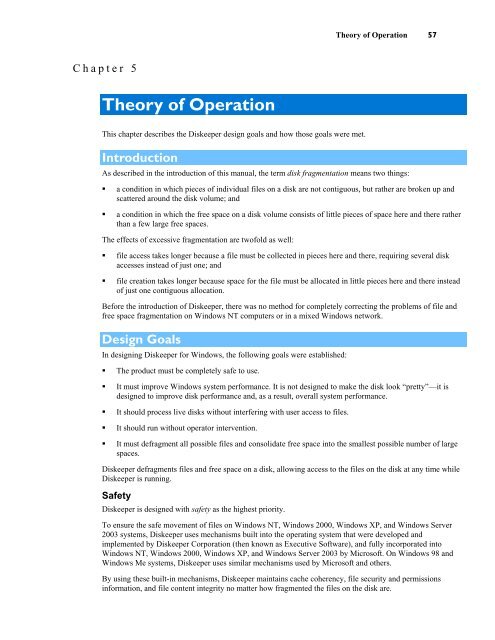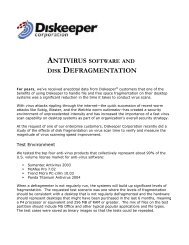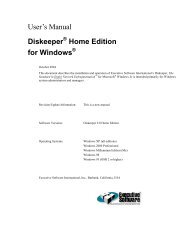Diskeeper 10 User's Manual
Diskeeper 10 User's Manual
Diskeeper 10 User's Manual
Create successful ePaper yourself
Turn your PDF publications into a flip-book with our unique Google optimized e-Paper software.
Theory of Operation 57<br />
Chapter 5<br />
Theory of Operation<br />
This chapter describes the <strong>Diskeeper</strong> design goals and how those goals were met.<br />
Introduction<br />
As described in the introduction of this manual, the term disk fragmentation means two things:<br />
• a condition in which pieces of individual files on a disk are not contiguous, but rather are broken up and<br />
scattered around the disk volume; and<br />
• a condition in which the free space on a disk volume consists of little pieces of space here and there rather<br />
than a few large free spaces.<br />
The effects of excessive fragmentation are twofold as well:<br />
• file access takes longer because a file must be collected in pieces here and there, requiring several disk<br />
accesses instead of just one; and<br />
• file creation takes longer because space for the file must be allocated in little pieces here and there instead<br />
of just one contiguous allocation.<br />
Before the introduction of <strong>Diskeeper</strong>, there was no method for completely correcting the problems of file and<br />
free space fragmentation on Windows NT computers or in a mixed Windows network.<br />
Design Goals<br />
In designing <strong>Diskeeper</strong> for Windows, the following goals were established:<br />
• The product must be completely safe to use.<br />
• It must improve Windows system performance. It is not designed to make the disk look “pretty”—it is<br />
designed to improve disk performance and, as a result, overall system performance.<br />
• It should process live disks without interfering with user access to files.<br />
• It should run without operator intervention.<br />
• It must defragment all possible files and consolidate free space into the smallest possible number of large<br />
spaces.<br />
<strong>Diskeeper</strong> defragments files and free space on a disk, allowing access to the files on the disk at any time while<br />
<strong>Diskeeper</strong> is running.<br />
Safety<br />
<strong>Diskeeper</strong> is designed with safety as the highest priority.<br />
To ensure the safe movement of files on Windows NT, Windows 2000, Windows XP, and Windows Server<br />
2003 systems, <strong>Diskeeper</strong> uses mechanisms built into the operating system that were developed and<br />
implemented by <strong>Diskeeper</strong> Corporation (then known as Executive Software), and fully incorporated into<br />
Windows NT, Windows 2000, Windows XP, and Windows Server 2003 by Microsoft. On Windows 98 and<br />
Windows Me systems, <strong>Diskeeper</strong> uses similar mechanisms used by Microsoft and others.<br />
By using these built-in mechanisms, <strong>Diskeeper</strong> maintains cache coherency, file security and permissions<br />
information, and file content integrity no matter how fragmented the files on the disk are.






